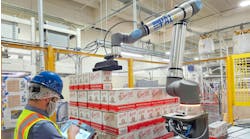Yokogawa’s Y Now 2021 virtual event takes place November 2-4, and it promises to tackle the questions on the tips of everyone’s tongues regarding autonomous operations, as organizations emerge from their COVID-induced comas and begin to figure out how to proceed, produce and profit in the new economy.
Autonomous operations could play a big role in that future. “We recognize our ability to measure and connect is a core competency,” said Yokogawa’s Kevin McMillen, president and CEO, North America, prior to the Y Now event. “That helps us to add value across multiple industries. Through autonomy and symbiosis, Yokogawa will create sustainable value and lead the way in solving global issues.”
As the company moves from an organization centered on products and functions to one based on business segments that include energy and sustainability, materials and life, value will be provided through a system of systems, explained McMillen. This concept—industrial automation to industrial autonomy (IA2IA)— includes multiple independently operating systems that are coordinated to promote effective connectivity and create value through overall optimization driven by integration, autonomy and digitalization. Yokogawa Cloud will provide the supporting path for these technologies.
The convergence
“About seven or eight years ago, it was an unprecedented time for the automation industry,” explained Tom Fiske, Ph.D., principal technology strategist, Yokogawa. The cloud, sensors, edge technology, artificial intelligence (AI), robotics and 5G were all coming together. “Where was this headed?” he asked. “We started talking about Industry 4.0 and digital transformation, which has impacted every aspect of society. It’s also impacted the way we operate our facilities. It applies to the entire enterprise.”
The next step is IA2IA, said Fiske. “We have a maturity model that goes from manual operations to autonomous,” he explained. “As we move into semi-autonomous, there will be a lot of autonomous components that are like an automobile being driven.” Certain automotive functions are automated, but there is still a driver who makes decisions and manually operates other systems of the vehicle.
Also read: Data-driven skill sets bring new perspectives
“Autonomous brings together all of the systems to work together as a whole,” explained Fiske. “Within that, there are companies focused on remote operations. They’re focused on removing people from dangerous areas or hazardous jobs. For more complicated operations, autonomous operations will be more effective.”
To the cloud
The ISA Purdue Model has been around since 1995, said Joseph Ting, vice president of digital customer experience, Yokogawa, who recalled how different things were in 1995. “Everyone was operating on premise,” he reminded. “Larger companies had data centers, but the disruptive effects of cloud weren’t obvious to most people in 1995.”
While the benefits of cloud are obvious in 2021, not a lot of customers want to be the first to adopt technologies such as cloud at the bleeding edge, so making users comfortable and confident is important, said Fiske.
“The Yokogawa Cloud is platform-agnostic,” he explained. “We can install on other platforms or on premise, too. We are cloudifying all of our software on this platform. We’ve been proceeding with engineered solutions. Many larger companies are establishing their own platforms, and, with the extension and capabilities of cloud, we’re able to offer that, as well.”
Autonomy in just a robotic arm’s length away
AI is an important component in autonomous plant operation and in Yokogawa’s IA2IA singularity. “Three AI modules hold the key,” explained Hiroaki Kanokogi, Ph.D., general manager, control center, Yokogawa. Those modules include AI that analyzes the present state; AI to explore control methods; and AI to find and define potential problems.
Maximum theoretical operational efficiency will be achieved autonomously. Plan-do-check-act (PDCA) loops to improve key performance indicators (KPIs) traditionally include human actions, said Kanakogi. A plant makes big data using various centers. Engineers try to find potential problems. “Once the problem is identified, it is passed to the data scientist to find the root cause or the KPI,” he explained. “Then it’s passed to the field engineer. The methods are applied to the plant by the engineers. This loop takes six months or one year. If we replace the scientists and engineers with AI, this loop runs autonomously 24 hours/seven days until we reach the theoretical maximum, which is not infinite.”
To enable these autonomous operations, robotics bring the eye, ear, nose and hand capabilities. “Robotics is not a new process,” explained Penny Chen, senior principal technology strategist, Yokogawa. “For a long time, it has been used for specific applications. Robotics is a key enabler for industrial autonomy.”






